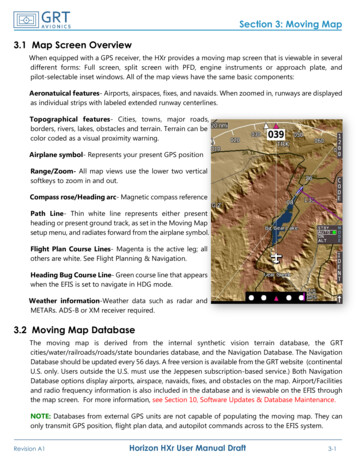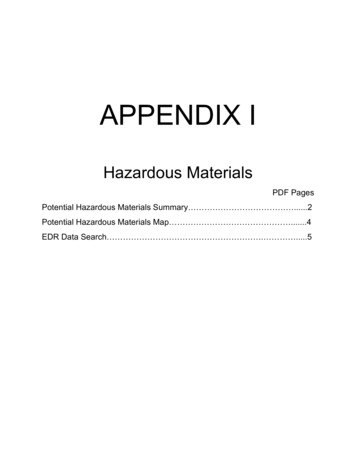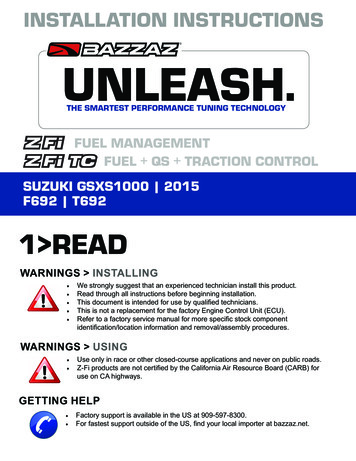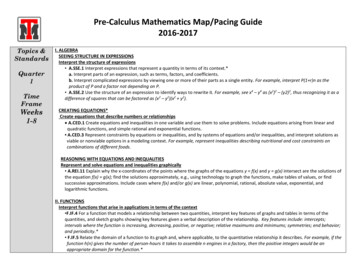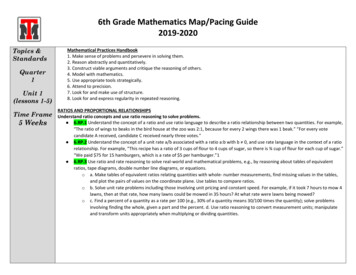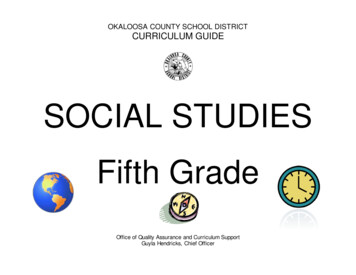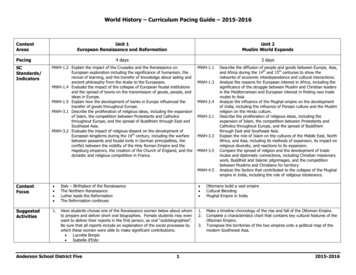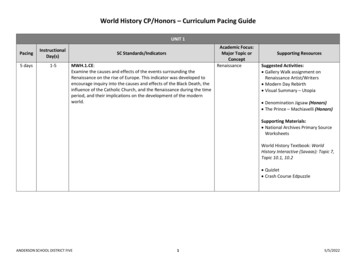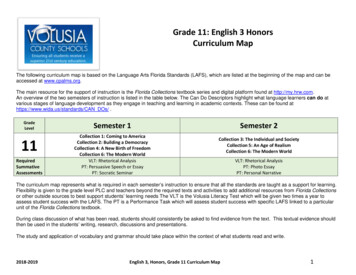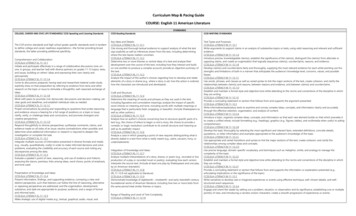
Transcription
Curriculum Map & Pacing GuideCOURSE: English 11 American LiteratureSTANDARDSCOLLEGE, CAREER AND CIVIC LIFE STANDARDS/ CCSS Speaking and Listening StandardsThe CCR anchor standards and high school grade-specific standards work in tandemto define college and career readiness expectations—the former providing broadstandards, the latter providing additional specificity.Comprehension and Collaboration:CCSS.ELA-LITERACY.SL.11-12.1Initiate and participate effectively in a range of collaborative discussions (one-onone, in groups, and teacher-led) with diverse partners on grades 11-12 topics, texts,and issues, building on others' ideas and expressing their own clearly andpersuasively.CCSS.ELA-LITERACY.SL.11-12.1.ACome to discussions prepared, having read and researched material under study;explicitly draw on that preparation by referring to evidence from texts and otherresearch on the topic or issue to stimulate a thoughtful, well-reasoned exchange ofideas.CCSS.ELA-LITERACY.SL.11-12.1.BWork with peers to promote civil, democratic discussions and decision-making, setclear goals and deadlines, and establish individual roles as needed.CCSS.ELA-LITERACY.SL.11-12.1.CPropel conversations by posing and responding to questions that probe reasoningand evidence; ensure a hearing for a full range of positions on a topic or issue;clarify, verify, or challenge ideas and conclusions; and promote divergent andcreative perspectives.CCSS.ELA-LITERACY.SL.11-12.1.DRespond thoughtfully to diverse perspectives; synthesize comments, claims, andevidence made on all sides of an issue; resolve contradictions when possible; anddetermine what additional information or research is required to deepen theinvestigation or complete the task.CCSS.ELA-LITERACY.SL.11-12.2Integrate multiple sources of information presented in diverse formats and media(e.g., visually, quantitatively, orally) in order to make informed decisions and solveproblems, evaluating the credibility and accuracy of each source and noting anydiscrepancies among the data.CCSS.ELA-LITERACY.SL.11-12.3Evaluate a speaker's point of view, reasoning, and use of evidence and rhetoric,assessing the stance, premises, links among ideas, word choice, points of emphasis,and tone used.Presentation of Knowledge and Ideas:CCSS.ELA-LITERACY.SL.11-12.4Present information, findings, and supporting evidence, conveying a clear anddistinct perspective, such that listeners can follow the line of reasoning, alternativeor opposing perspectives are addressed, and the organization, development,substance, and style are appropriate to purpose, audience, and a range of formaland informal tasks.CCSS.ELA-LITERACY.SL.11-12.5Make strategic use of digital media (e.g., textual, graphical, audio, visual, andCCSS Reading StandardsCCSS WRITING STANDARDSKey Ideas and Details:CCSS.ELA-LITERACY.RL.11-12.1Cite strong and thorough textual evidence to support analysis of what the textsays explicitly as well as inferences drawn from the text, including determiningwhere the text leaves matters uncertain.CCSS.ELA-LITERACY.RL.11-12.2Determine two or more themes or central ideas of a text and analyze theirdevelopment over the course of the text, including how they interact and buildon one another to produce a complex account; provide an objective summary ofthe text.CCSS.ELA-LITERACY.RL.11-12.3Analyze the impact of the author's choices regarding how to develop and relateelements of a story or drama (e.g., where a story is set, how the action is ordered,how the characters are introduced and developed).Text Types and Purposes:CCSS.ELA-LITERACY.W.11-12.1Write arguments to support claims in an analysis of substantive topics or texts, using valid reasoning and relevant and troduce precise, knowledgeable claim(s), establish the significance of the claim(s), distinguish the claim(s) from alternate oropposing claims, and create an organization that logically sequences claim(s), counterclaims, reasons, and evidence.CCSS.ELA-LITERACY.W.11-12.1.BDevelop claim(s) and counterclaims fairly and thoroughly, supplying the most relevant evidence for each while pointing out thestrengths and limitations of both in a manner that anticipates the audience's knowledge level, concerns, values, and possiblebiases.CCSS.ELA-LITERACY.W.11-12.1.CUse words, phrases, and clauses as well as varied syntax to link the major sections of the text, create cohesion, and clarify therelationships between claim(s) and reasons, between reasons and evidence, and between claim(s) and sh and maintain a formal style and objective tone while attending to the norms and conventions of the discipline in whichthey are writing.CCSS.ELA-LITERACY.W.11-12.1.EProvide a concluding statement or section that follows from and supports the argument presented.CCSS.ELA-LITERACY.W.11-12.2Write informative/explanatory texts to examine and convey complex ideas, concepts, and information clearly and accuratelythrough the effective selection, organization, and analysis of content.CCSS.ELA-LITERACY.W.11-12.2.AIntroduce a topic; organize complex ideas, concepts, and information so that each new element builds on that which precedes itto create a unified whole; include formatting (e.g., headings), graphics (e.g., figures, tables), and multimedia when useful to evelop the topic thoroughly by selecting the most significant and relevant facts, extended definitions, concrete details,quotations, or other information and examples appropriate to the audience's knowledge of the topic.CCSS.ELA-LITERACY.W.11-12.2.CUse appropriate and varied transitions and syntax to link the major sections of the text, create cohesion, and clarify therelationships among complex ideas and concepts.CCSS.ELA-LITERACY.W.11-12.2.DUse precise language, domain-specific vocabulary, and techniques such as metaphor, simile, and analogy to manage thecomplexity of the topic.CCSS.ELA-LITERACY.W.11-12.2.EEstablish and maintain a formal style and objective tone while attending to the norms and conventions of the discipline in whichthey are writing.CCSS.ELA-LITERACY.W.11-12.2.FProvide a concluding statement or section that follows from and supports the information or explanation presented (e.g.,articulating implications or the significance of the topic).CCSS.ELA-LITERACY.W.11-12.3Write narratives to develop real or imagined experiences or events using effective technique, well-chosen details, and wellstructured event sequences.CCSS.ELA-LITERACY.W.11-12.3.AEngage and orient the reader by setting out a problem, situation, or observation and its significance, establishing one or multiplepoint(s) of view, and introducing a narrator and/or characters; create a smooth progression of experiences or events.Craft and Structure:CCSS.ELA-LITERACY.RL.11-12.4Determine the meaning of words and phrases as they are used in the text,including figurative and connotative meanings; analyze the impact of specificword choices on meaning and tone, including words with multiple meanings orlanguage that is particularly fresh, engaging, or beautiful. (Include Shakespeare aswell as other authors.)CCSS.ELA-LITERACY.RL.11-12.5Analyze how an author's choices concerning how to structure specific parts of atext (e.g., the choice of where to begin or end a story, the choice to provide acomedic or tragic resolution) contribute to its overall structure and meaning aswell as its aesthetic impact.CCSS.ELA-LITERACY.RL.11-12.6Analyze a case in which grasping a point of view requires distinguishing what isdirectly stated in a text from what is really meant (e.g., satire, sarcasm, irony, orunderstatement).Integration of Knowledge and Ideas:CCSS.ELA-LITERACY.RL.11-12.7Analyze multiple interpretations of a story, drama, or poem (e.g., recorded or liveproduction of a play or recorded novel or poetry), evaluating how each versioninterprets the source text. (Include at least one play by Shakespeare and one playby an American dramatist.)CCSS.ELA-LITERACY.RL.11-12.8(RL.11-12.8 not applicable to literature)CCSS.ELA-LITERACY.RL.11-12.9Demonstrate knowledge of eighteenth-, nineteenth- and early-twentieth-centuryfoundational works of American literature, including how two or more texts fromthe same period treat similar themes or topics.Range of Reading and Level of Text Complexity:CCSS.ELA-LITERACY.RL.11-12.10
interactive elements) in presentations to enhance understanding of findings,reasoning, and evidence and to add interest.CCSS.ELA-LITERACY.SL.11-12.6Adapt speech to a variety of contexts and tasks, demonstrating a command offormal English when indicated or appropriate. (See grades 11-12 Languagestandards 1 and 3 here for specific expectations.)By the end of grade 11, read and comprehend literature, including stories,dramas, and poems, in the grades 11-CCR text complexity band proficiently, withscaffolding as needed at the high end of the range.By the end of grade 12, read and comprehend literature, including stories,dramas, and poems, at the high end of the grades 11-CCR text complexity bandindependently and proficiently.Key Ideas and Details:CCSS.ELA-LITERACY.RI.11-12.1Cite strong and thorough textual evidence to support analysis of what the textsays explicitly as well as inferences drawn from the text, including determiningwhere the text leaves matters uncertain.CCSS.ELA-LITERACY.RI.11-12.2Determine two or more central ideas of a text and analyze their developmentover the course of the text, including how they interact and build on one anotherto provide a complex analysis; provide an objective summary of the text.CCSS.ELA-LITERACY.RI.11-12.3Analyze a complex set of ideas or sequence of events and explain how specificindividuals, ideas, or events interact and develop over the course of the text.Craft and Structure:CCSS.ELA-LITERACY.RI.11-12.4Determine the meaning of words and phrases as they are used in a text, includingfigurative, connotative, and technical meanings; analyze how an author uses andrefines the meaning of a key term or terms over the course of a text (e.g., howMadison defines faction in Federalist No. 10).CCSS.ELA-LITERACY.RI.11-12.5Analyze and evaluate the effectiveness of the structure an author uses in his orher exposition or argument, including whether the structure makes points clear,convincing, and engaging.CCSS.ELA-LITERACY.RI.11-12.6Determine an author's point of view or purpose in a text in which the rhetoric isparticularly effective, analyzing how style and content contribute to the power,persuasiveness or beauty of the text.Integration of Knowledge and Ideas:CCSS.ELA-LITERACY.RI.11-12.7Integrate and evaluate multiple sources of information presented in differentmedia or formats (e.g., visually, quantitatively) as well as in words in order toaddress a question or solve a problem.CCSS.ELA-LITERACY.RI.11-12.8Delineate and evaluate the reasoning in seminal U.S. texts, including theapplication of constitutional principles and use of legal reasoning (e.g., in U.S.Supreme Court majority opinions and dissents) and the premises, purposes, andarguments in works of public advocacy (e.g., The Federalist, 9Analyze seventeenth-, eighteenth-, and nineteenth-century foundational U.S.documents of historical and literary significance (including The Declaration ofIndependence, the Preamble to the Constitution, the Bill of Rights, and Lincoln'sSecond Inaugural Address) for their themes, purposes, and rhetorical features.CCSS.ELA-LITERACY.W.11-12.3.BUse narrative techniques, such as dialogue, pacing, description, reflection, and multiple plot lines, to develop experiences, events,and/or characters.CCSS.ELA-LITERACY.W.11-12.3.CUse a variety of techniques to sequence events so that they build on one another to create a coherent whole and build toward aparticular tone and outcome (e.g., a sense of mystery, suspense, growth, or resolution).CCSS.ELA-LITERACY.W.11-12.3.DUse precise words and phrases, telling details, and sensory language to convey a vivid picture of the experiences, events, setting,and/or characters.CCSS.ELA-LITERACY.W.11-12.3.EProvide a conclusion that follows from and reflects on what is experienced, observed, or resolved over the course of thenarrative.Production and Distribution of Writing:CCSS.ELA-LITERACY.W.11-12.4Produce clear and coherent writing in which the development, organization, and style are appropriate to task, purpose, andaudience. (Grade-specific expectations for writing types are defined in standards 1-3 above.)CCSS.ELA-LITERACY.W.11-12.5Develop and strengthen writing as needed by planning, revising, editing, rewriting, or trying a new approach, focusing onaddressing what is most significant for a specific purpose and audience. (Editing for conventions should demonstrate commandof Language standards 1-3 up to and including grades 11-12 here.)CCSS.ELA-LITERACY.W.11-12.6Use technology, including the Internet, to produce, publish, and update individual or shared writing products in response toongoing feedback, including new arguments or information.Research to Build and Present Knowledge:CCSS.ELA-LITERACY.W.11-12.7Conduct short as well as more sustained research projects to answer a question (including a self-generated question) or solve aproblem; narrow or broaden the inquiry when appropriate; synthesize multiple sources on the subject, demonstratingunderstanding of the subject under investigation.CCSS.ELA-LITERACY.W.11-12.8Gather relevant information from multiple authoritative print and digital sources, using advanced searches effectively; assess thestrengths and limitations of each source in terms of the task, purpose, and audience; integrate information into the textselectively to maintain the flow of ideas, avoiding plagiarism and overreliance on any one source and following a standard formatfor citation.CCSS.ELA-LITERACY.W.11-12.9Draw evidence from literary or informational texts to support analysis, reflection, and research.CCSS.ELA-LITERACY.W.11-12.9.AApply grades 11-12 Reading standards to literature (e.g., "Demonstrate knowledge of eighteenth-, nineteenth- and earlytwentieth-century foundational works of American literature, including how two or more texts from the same period treat similarthemes or topics").CCSS.ELA-LITERACY.W.11-12.9.BApply grades 11-12 Reading standards to literary nonfiction (e.g., "Delineate and evaluate the reasoning in seminal U.S. texts,including the application of constitutional principles and use of legal reasoning [e.g., in U.S. Supreme Court Case majorityopinions and dissents] and the premises, purposes, and arguments in works of public advocacy [e.g., The Federalist, presidentialaddresses]").Range of Writing:CCSS.ELA-LITERACY.W.11-12.10Write routinely over extended time frames (time for research, reflection, and revision) and shorter time frames (a single sitting ora day or two) for a range of tasks, purposes, and audiences.
Range of Reading and Level of Text Complexity:CCSS.ELA-LITERACY.RI.11-12.10By the end of grade 11, read and comprehend literary nonfiction in the grades11-CCR text complexity band proficiently, with scaffolding as needed at the highend of the range.By the end of grade 12, read and comprehend literary nonfiction at the high endof the grades 11-CCR text complexity band independently and proficiently.PACINGUNITSUnit 1 Focus: Indigenous and ColonialExperiences and OriginsBIG IDEAS /ESSENTIAL QUESTIONS Who owns theland and who hasthe right to rule? What are theearly historicalcontexts ofAmericanLiterature andIdentity? How areownership,leadership, anddemocracydetermined anddebated? How doestaking intoconsiderationvoices andperspectiveswithin a timeperiod contributeto a greaterunderstanding ofourselves and ourorigins?ASSURED EXPERIENCES & ASSESSMENTSCONTENTAnchor Texts: “The World on theTurtle’s Back” - IroquoisCreation Myth "Sinners in the Handsof an Angry God" Sermon by JonathanEdwards “The InterestingNarrative of the Life ofOlaudah Equiano” byOlaudah EquianoSupplemental Texts William Wilberforce's1789 Abolition Speech Sources (articles,images, or othercredible informativetexts) for PBL SemesterResearch Project "How to Choose aResearchTopic” by University ofMichigan FlintSuggested CIF ProtocolsINSTRUCTIONALSTRATEGIESGoal of the Unit: Students will analyze literature withinCIF Strategiesa historical and cultural context, develop skills for reading older Reduce,texts, and understand storytelling traditions andRecord, Reflecttechniques, including identifying and applying characteristics of Read, Write,creation stories and early American essays and speeches toSharetheir own writing. JigsawAssessments: CornersSummative:Other Instructional Bridgeport Creation Myth creative writing assignmentStrategies. Rhetorical Analysis Compare/ContrastCLOSE Reading ExplicitEssay Rubric her\e.Vocabulary Instruction PBL Semester Research Project Part 1: Community(i.e., FACADES) ExplicitProblem / Social Issue Identification & PowerPointVocabulary (i.e.,PresentationAcademic Vocabulary)Explicit VocabularyFormative:(i.e., structural analysis Write routinely and over extended time frames (selfwith affixes and roots)assessment and reflections) and shorter time framesUse of RACE and/or(free writes and ungraded responses)SURE Rubric with Teacher observation and interactionStudents Use of Text Peer and teacher feedback during the writing processDependent and PairedQuestions IdentifyingSimilarities &DifferencesSummarizing &Notetaking ReinforcingEffort & Providing
What strategiesdo speakers andwriters use toconvey theirmessage to aparticularaudience?Unit 2 Focus: 19th Century –Romanticism and Reality How do weaddressdichotomieslike Nature andScience?Idealism andReality?Freedom andTradition?What factors inour life impactour views onsocial issues?What influencedoes readingfirsthandaccounts haveon ourunderstanding Reduce, Record,Reflect Read, Write, Share Jigsaw CornersAnchor Texts: Narrative of the Lifeof FrederickDouglass: AnAmerican Slave “The Tell-Tale Heart”by Edgar Allan PoeSupplemental Texts: Poem: “Success IsCounted Sweetest”by Emily Dickinson Poem: “I heard a Flybuzz-when I died” byEmily Dickinson Poem: ”I Heard aFuneral, in my Brain”by Emily DickinsonGoal of the Unit: Students will develop critical thinking andresearch skills through exploration of 19th century texts in theirhistorical and social context, including recognizing and applyinguse of rhetorical strategies to convey a message.Summative: Abolition of Slavery Speech or Editorial PBL Semester Research Project Part 2: LiteratureReview, Research Question, and Thesis StatementFormative: Formative response papers and opinion journalresponses Write routinely and over extended time frames (selfassessment and reflections) and shorter time frames(free writes and ungraded responses) Teacher observation and interaction Peer and teacher feedbackRecognitionHomework & PracticeNonlinguisticRepresentationsCooperative LearningGroupsSetting Objectives &Providing FeedbackCues, questions, andadvance organizersWriting-to-LearnCollaborative GroupWork Classroom TalkScaffolding LiteracyGroups Socratic andPaideia seminarStudent-CenteredLearning Project-BasedLearningCIF Strategies Reduce,Record, Reflect Read, Write,Share Jigsaw CornersOther InstructionalStrategies.CLOSE Reading ExplicitVocabulary Instruction(i.e., FACADES) ExplicitVocabulary (i.e.,Academic Vocabulary)Explicit Vocabulary(i.e., structural analysiswith affixes and roots)Use of RACE and/orSURE Rubric withStudents Use of TextDependent and Paired
of a particulartime period inhistory?Why is itimportant tohave academicand personalintegrity? Poem: “The Raven”by Edgar Allan PoePoetry 180 (studentchoice of poem)Sources (articles,images, or othercredible informativetexts) for PBLSemester ResearchProject"How to Choose aResearch Topic” byUniversity ofMichigan - FlintExcerpts on“Evaluating Sourcesand Writing anAnnotatedBibliography” fromThe St. Martin’sHandbook by AndreaA. LunsfordExcerpts on “Posing aResearch Questionand Evaluating WebSources” from APocket Style Manual,Fifth Edition by DianaHacker“Source CitationUsing MLA Style”from The BedfordReader, 12th editionby X.J. Kennedy,Dorothy M. Kennedy,Questions IdentifyingSimilarities &DifferencesSummarizing &Notetaking ReinforcingEffort & ProvidingRecognitionHomework & PracticeNonlinguisticRepresentationsCooperative LearningGroupsSetting Objectives &Providing FeedbackCues, questions, andadvance organizersWriting-to-LearnCollaborative GroupWork Classroom TalkScaffolding LiteracyGroups Socratic andPaideia seminarStudent-CenteredLearning Project-BasedLearning
Jane E. Aaron, andEllen Kuhl RepettoSuggested CIF Protocols Reduce, Record,Reflect 3-2-1 Questioning Jigsaw CornersUnit 3 Focus: 20th Century Writing:War and Peace, Rights andRenaissanceEssential Questions: What role doesliterature play inconstructing andexpressingindividual andcultural identity? How doliterature, art, andwords drive socialand culturalchange? How doeswriting helpnegotiate therelationship of theindividual to thegroup?Anchor Texts: Poems: “I HearAmerica Singing”, “Songof Myself” and “Beat!Beat! Drums!” by WaltWhitman Their Eyes WereWatching God – ZoraNeale Hurston Letter from aBirmingham Jail byMartin Luther King Jr. “Let America BeAmerican Again –Langston Hughes TED Talk “We ShouldAll Be Feminists byChimamanda NgoziAdichieSupplemental Texts: (Gender: The Story ofan Hour- Kate Chopin)Goal of the Unit: Students will explore the role of the novel incultural identity and personal expression. Students will extendtheir understandings of rhetoric and social change throughreadings of essential 20th century texts.Assessments:Summative: PBL Research Project Part 3: Research Proposal &Approval Rhetorical Analysis (Connected with Dr. King’s“Letter”)Formative: Response papers and opinion journals PBL Research Project conferencing Write routinely and over extended time frames (selfassessment and reflections) and shorter time frames (freewrites and ungraded responses) Teacher observation and interaction Peer and teacher feedbackCIF StrategiesSuggested CIFProtocols Valley ofValues Jig SawWrite-PairShare & WritePair-Pair-Share 3 MinuteReviewOther InstructionalStrategies.CLOSE Reading ExplicitVocabulary Instruction(i.e., FACADES) ExplicitVocabulary (i.e.,Academic Vocabulary)Explicit Vocabulary(i.e., structural analysiswith affixes and roots)Use of RACE and/or
(Gender: The YellowWallpaper – CharlottePerkins Gilman (Gender) Malala’sMagic Pencil by MalalaYousafzai (Race) Chapter 23 of“I Know Why the CagedBird Sings by MayaAngelou The New YorkTimes UpFront Magazine& other current events stUnit 4 Focus: Empowering 21Century American Identity & Voice What doesliterature andlanguage looklike in the 21stcentury?How do wedefine anddevelop ourroles in thefuture?Anchor Texts: The Tempest byWilliam Shakespeare Selections of moderntexts, music,journalism, essays,and social media/broadcast media witha focus on Latina/o,Black, Indigenous,LGBTQ, newlyGoal of the Unit: Students will develop an understanding of21st century writing and thought, and engage their own voicein the writing of the future.Summative: PBL Action Research Paper – Final Paper and ActionComponent Shakespeare Analysis or ResponseFormative: Self-ReflectionSURE Rubric withStudents Use of TextDependent and PairedQuestions IdentifyingSimilarities &DifferencesSummarizing &Notetaking ReinforcingEffort & ProvidingRecognitionHomework & PracticeNonlinguisticRepresentationsCooperative LearningGroupsSetting Objectives &Providing FeedbackCues, questions, andadvance organizersWriting-to-LearnCollaborative GroupWork Classroom TalkScaffolding LiteracyGroups Socratic andPaideia seminarStudent-CenteredLearning Project-BasedLearningCIF Strategies Reduce,Record, Reflect Read, Write,Share Jigsaw CornersOther InstructionalStrategies.CLOSE Reading ExplicitVocabulary Instruction(i.e., FACADES) Explicit
How can wordsshape thesociety world ofthe future?immigrated, andhistorically oppressedvoices.Supplemental Texts: (Race) TED Talk “JustMercy” by BryanStevensonSuggested CIF Protocols Valley of Values Gallery Walk Fishbowl Back to Back Write routinely and over extended time frames (selfassessment and reflections) and shorter time frames(free writes and ungraded responses)Teacher observation and interactionPeer and teacher feedbackVocabulary (i.e.,Academic Vocabulary)Explicit Vocabulary(i.e., structural analysiswith affixes and roots)Use of RACE and/orSURE Rubric withStudents Use of TextDependent and PairedQuestions IdentifyingSimilarities &DifferencesSummarizing &Notetaking ReinforcingEffort & ProvidingRecognitionHomework & PracticeNonlinguisticRepresentationsCooperative LearningGroupsSetting Objectives &Providing FeedbackCues, questions, andadvance organizersWriting-to-LearnCollaborative GroupWork Classroom TalkScaffolding LiteracyGroups Socratic andPaideia seminarStudent-CenteredLearning Project-BasedLearning
Curriculum Map & Pacing Guide COURSE: English 11 American Literature STANDARDS . formal English when indicated or appropriate. (See grades 11-12 Language standards 1 and 3 here for specific expectations.) By the end of grade 12, read and comprehend literature, including stories, By the end of grade 11, read and comprehend literature .
